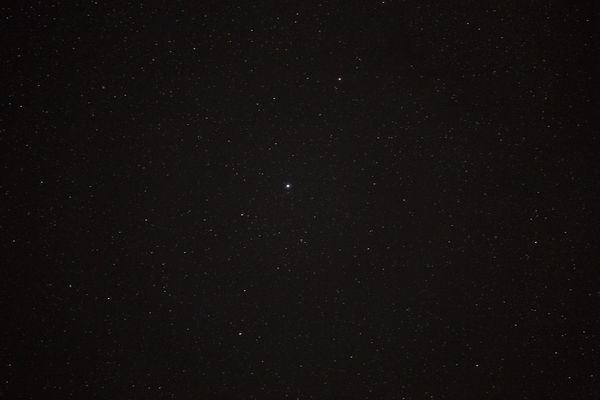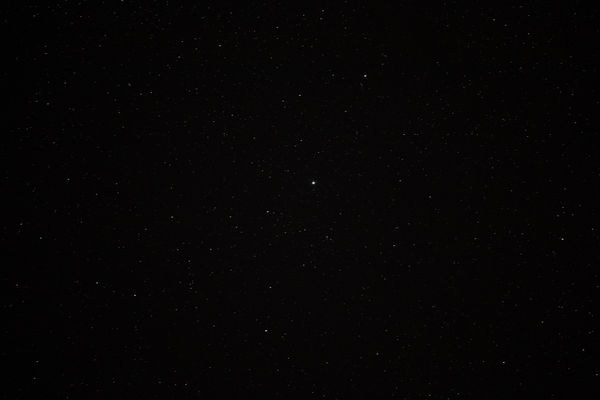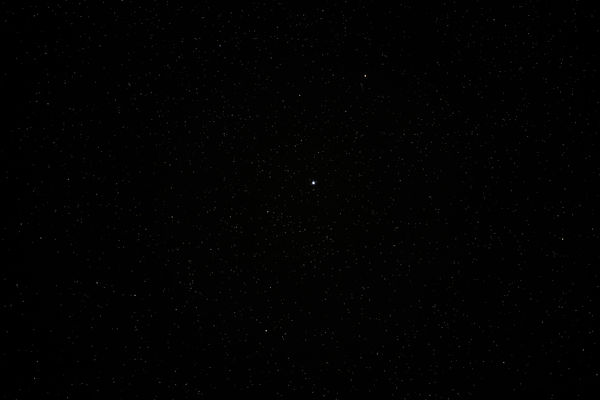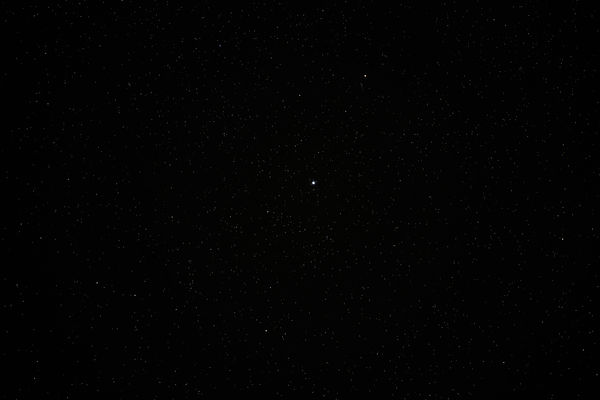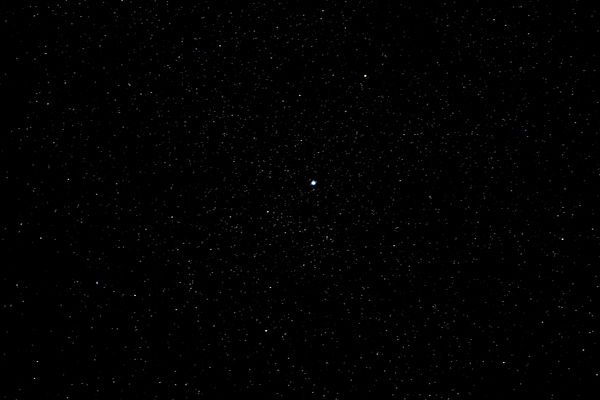three stars
Aug 22, 2015 00:35:01 #
somewhere s-s-se perhaps 60 or 65 degrees.
Took 16 light frames and 9 dark ones and attempted deepSkyStacker just to see if I could get through the process.
Used Canon 6D and 70-200mm lens at 200 mm. Was at 4000 ISO F/4 for five seconds. Way too long apparently, see severe streaking when viewed at 100 percent.
First image is first frame - reduced to 8-bit jpg.
Second image was stack. Loaded stacked image into PS, converted 32 bit to 16 bit, applied DFINE against darker pixels and set it to 25 percent or so. Applied levels and sharpened and then set to 8 bit and saved jpg.
Any advise to any aspect of this is much appreciated. I guess I'm glad I didn't attempt this first try with my 400mm lens.
Also attempted to find these three stars using sky safari app, but got hopelessly lost... No surprise there.
Took 16 light frames and 9 dark ones and attempted deepSkyStacker just to see if I could get through the process.
Used Canon 6D and 70-200mm lens at 200 mm. Was at 4000 ISO F/4 for five seconds. Way too long apparently, see severe streaking when viewed at 100 percent.
First image is first frame - reduced to 8-bit jpg.
Second image was stack. Loaded stacked image into PS, converted 32 bit to 16 bit, applied DFINE against darker pixels and set it to 25 percent or so. Applied levels and sharpened and then set to 8 bit and saved jpg.
Any advise to any aspect of this is much appreciated. I guess I'm glad I didn't attempt this first try with my 400mm lens.
Also attempted to find these three stars using sky safari app, but got hopelessly lost... No surprise there.
Aug 22, 2015 02:25:37 #
pfrancke wrote:
somewhere s-s-se perhaps 60 or 65 degrees. br b... (show quote)
You have done pretty good for your first try. I have about 6 or so tutorials for DeepSkyStacker that I have printed out, and I am still studying the various settings to see what they can do for the image.
I downloaded your stacked JPG and did two things to it.
1) I used Focus Magic to attempt to reduce the length of your star trails. It has a range of about 20 pixels and it almost succeeded. The trails are considerably shorter.
2) I loaded that result into Lightroom and worked on the noise. Since I was working on a JPG, and a multi-saved JPG at that, I was limited in what I could do, but I did make the noise level go down. I also cheated and adjusted the Darks so that the dark clipped effectively hiding the noise.
The latest setting I have been playing with in DSS is the one that reduces the pixel count by a factor of 4. You still see the same number of stars, but the compression really reduces the noise.
I have taken the image I had worked on and processed it through StarTools. It takes each star and redistributes the pixels associated with each star to make them more perfect points of light. I think you can see it effect when you magnify.
Good start!
Aug 22, 2015 08:57:03 #
that is amazing what can be done even with a jpg. I was thinking when I saw the trails, that I was surprised that specialized software didn't exist that dealt with it. In fact, if the software knows the length and direction of a trail, I would expect the software to know how to do noise removal and trail clean-up from such information. The software certainly could know from that the difference between the "seen" and the "noise". Trails should be considered "extra" information to such a program.
Also, good idea about the DSS Pixel reducing strategy - I need to figure that out. Thanks.
Anyway, sorry for the rambling and thank you very much for pointing out that small trails CAN be dealt with.
It is amazing what a camera and lens can see. My memory of what I could see is about like one of these images before you hit the download button.
Also, good idea about the DSS Pixel reducing strategy - I need to figure that out. Thanks.
Anyway, sorry for the rambling and thank you very much for pointing out that small trails CAN be dealt with.
It is amazing what a camera and lens can see. My memory of what I could see is about like one of these images before you hit the download button.
Aug 22, 2015 11:15:44 #
pfrancke wrote:
that is amazing what can be done even with a jpg. ... (show quote)
I have also often thought that there should be software designed to detect and reduce star trails and to then be able to determine what is noise since it doesn't have trails. I haven't seen such SW offered by anyone, but it would certainly be doable.
I also am amazed at what the camera can see. I like to compare the images, when I know what star I am looking at, and to see what is the faintest magnitude star that is recorded in the image. I use a SW application called StarryNight for this. Without the camera, in my light polluted backyard, I struggle to see 4th magnitude stars. Using my 300mm F2.8 for just 2 sec, without using a drive, I can see in excess of 12th magnitude. With my 8" reflector, with a 30 sec exposure, it is recording to around the 15th or 16th magnitude!
What I also see is that using greater magnification, I see that there is a difference in the faint stars positions as recorded in StarryNight vs what I record in the image showing some long term star movement. The stars were recorded in some sky database some years ago and over time, the stars continue to move and those movements are noticeable when compared at higher magnifications.
Aug 22, 2015 11:19:37 #
JimH123 wrote:
You have done pretty good for your first try. I h... (show quote)
Wow Jim.
Big difference!
Keep at it Piet! ;)
Aug 22, 2015 11:35:51 #
SonnyE wrote:
Wow Jim.
Big difference!
Keep at it Piet! ;)
Big difference!
Keep at it Piet! ;)
Thank you Sonny. I am glad that you have survived the trip to the desert. Not everyone comes back from such an expedition!
Aug 22, 2015 11:42:02 #
JimH123 wrote:
I have also often thought that there should be sof... (show quote)
I did not know that the night sky would change so rapidly! To my feeble mind, for this to occur it means that stars are moving in relationship to each other at faster than the speed of light. And that to me in turn means that we must be witnessing the blending or rather collision of what where once different galaxies. unless I guess things are moving further apart and it is a pov thing..
Edit.. If this is stars spreading out, then that means we have calculated the center point and know where it is. Someone must have a 3d simulation of this already.
Aug 22, 2015 11:56:07 #
pfrancke wrote:
Thank you Sonny. I am glad that you have survived the trip to the desert. Not everyone comes back from such an expedition!
:lol: :lol: :lol:
It was actually cooler than being at home. :shock:
Temperature in Joshua Tree NP was ~ 95 F; and breezy, which helped.
Came home to 100 + with humidity. :P
Not to mention the light pollution.... :-(
Oh, but it's a dry heat! (In the desert)
The desert has a stark beauty of its own. ;)
Along the way home...
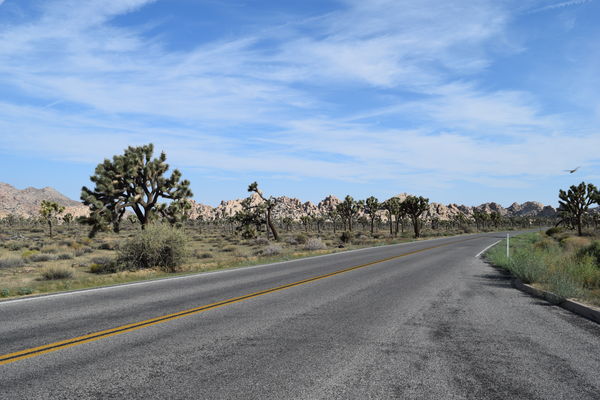
(Download)
Rotsa Rocks... Rots and rots of rocks...
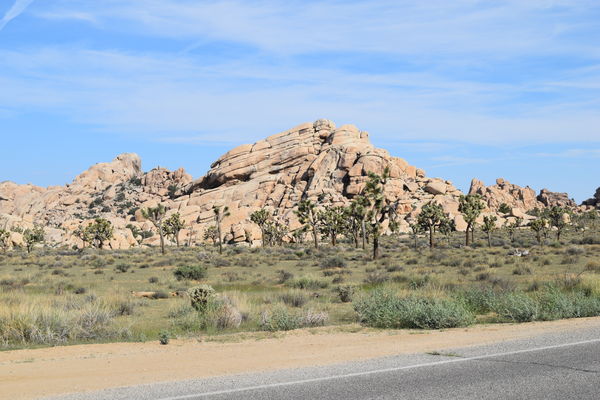
(Download)
...Even in death, there is a beauty.
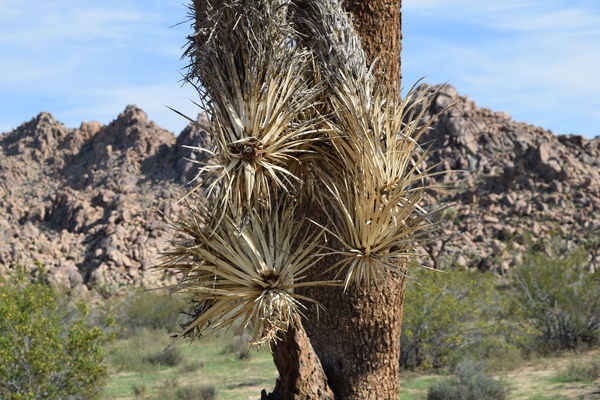
(Download)
Backed out, I found this dead tree Photogenic..
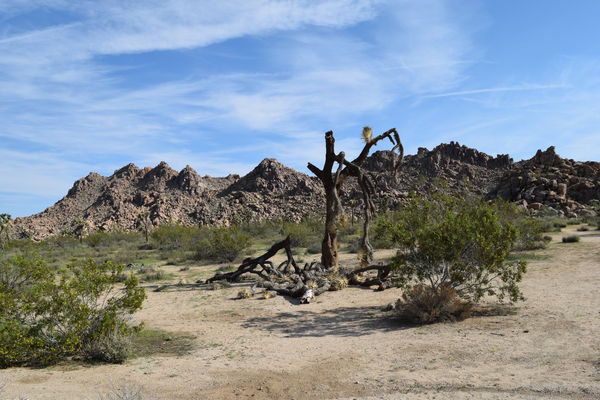
(Download)
Aug 22, 2015 12:16:13 #
SonnyE wrote:
:lol: :lol: :lol:
It was actually cooler than being at home. :shock:
Temperature in Joshua Tree NP was ~ 95 F; and breezy, which helped.
Came home to 100 + with humidity. :P
Not to mention the light pollution.... :-(
Oh, but it's a dry heat! (In the desert)
The desert has a stark beauty of its own. ;)
It was actually cooler than being at home. :shock:
Temperature in Joshua Tree NP was ~ 95 F; and breezy, which helped.
Came home to 100 + with humidity. :P
Not to mention the light pollution.... :-(
Oh, but it's a dry heat! (In the desert)
The desert has a stark beauty of its own. ;)
I was raised in Utah, and now that I am East, I have a great appreciation of "dry heat".
You guys are fighting smoke issues too I am sure.
Aug 22, 2015 13:27:43 #
pfrancke wrote:
I was raised in Utah, and now that I am East, I have a great appreciation of "dry heat".
You guys are fighting smoke issues too I am sure.
You guys are fighting smoke issues too I am sure.
Some smoke, but generally not as much as it might seem. A nearby wildfire gave us some of the smell of the fire, but no really visible interference, for example.
I loved Utah when we traveled through it both ways riding to Sturgis, SD in 1997. We had some very memorable times there.
Dry heat, yep. The wife's Dad and Step Mom live in Tennessee. She went to visit once during the summer.
Once being the lesson about their hot and humid weather... :lol:
But beauty is everywhere you look for it... ;)
Aug 22, 2015 13:31:47 #
pfrancke wrote:
I did not know that the night sky would change so ... (show quote)
To put it in better perspective, the stars we see are in out own galaxy, the Milky Way. Most of the stars we can actually see are relatively close and when you look in the direction of the center of the galaxy, you see the cloud of stars which we call the Milky Way.
Our sun and all the other stars are in orbit around the center of the galaxy. And from our perspective, they are orbiting at different speeds and as we look at them, there is a tiny amount of movement that can be seen if you wait long enough.
When you take a software package such as StarryNight, they are using a published star database taken some years ago. One big survey that was done was around 1950. That database has only the location of any given star at that moment in time. Now fast forward 65 years, and through a telescope, there is measurable movement in the positions of stars. The closer they are to us, the more noticeable the movement.
So with that in mind, when I capture an image through the telescope, and then compare with StarryNight, the stars are not exactly where they should be according to StarryNight. In fact, in some cases they have moved quite far. But it is also impossible to determine which stars have moved and which have moved not so much. In reality, it is likely the bright star that is used as a ref point that has moved, but we see it as an anchor point and look at all the dim stars and think that they were the ones that moved.
Anyway, it is beyond my feeble attempts to sort this out. So I basically just enjoy what I see.
Aug 22, 2015 13:36:13 #
pfrancke wrote:
I did not know that the night sky would change so ... (show quote)
A scientist who has spent his lifetime seeking the center....
I listened intently when I heard him speak. Dr. Hugh Ross.
Aug 22, 2015 16:44:54 #
pfrancke wrote:
somewhere s-s-se perhaps 60 or 65 degrees. br b... (show quote)
Hi pfrancke, back to your shots and the processing I took a try at it myself.
I processed it in Lightroom brought up some 'exoposure' and 'Black' down. The 'Dehaze' up and put in some 'Noise Reduction'. It still has some noise. Sorry I don't have Star Tools to round out the stars it's a wonderful App.
Aug 22, 2015 16:51:14 #
CraigFair wrote:
Hi pfrancke, back to your shots and the processing I took a try at it myself.
I processed it in Lightroom brought up some 'exoposure' and 'Black' down. The 'Dehaze' up and put in some 'Noise Reduction'. It still has some noise. Sorry I don't have Star Tools to round out the stars it's a wonderful App.
I processed it in Lightroom brought up some 'exoposure' and 'Black' down. The 'Dehaze' up and put in some 'Noise Reduction'. It still has some noise. Sorry I don't have Star Tools to round out the stars it's a wonderful App.
You could though, Craig. :twisted:
http://www.startools.org/
Aug 22, 2015 22:47:19 #
JimH123 wrote:
To put it in better perspective, the stars we see ... (show quote)
One would think that it is silly to try to photograph something that someone else (Hubble perhaps?) has already done over and over and so much better. Yet for some reason, I find it extremely satisfying. Like the stars I captured here, I need to find them and compare as you are saying and know what I am looking at - and strange how that is satisfying in a way that just looking at the best pictures already taken does not provide. Some kind of connection thing I guess..
If you want to reply, then register here. Registration is free and your account is created instantly, so you can post right away.
